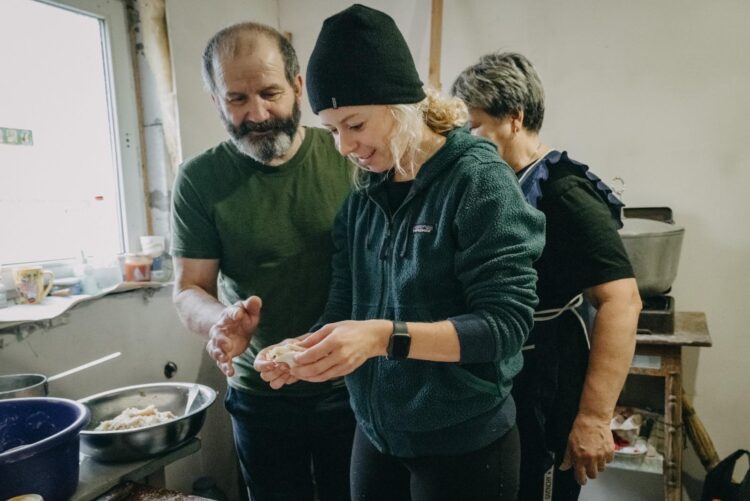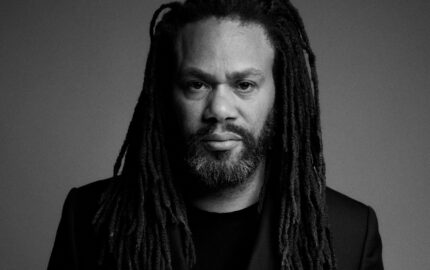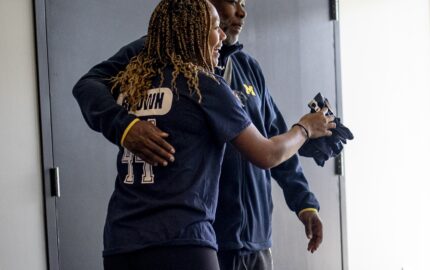Lizzie Johnson was a young reporter at the San Francisco Chronicle in 2018, covering local and state politics, when the deadliest wildfires in California swept through the region, all but destroying the small town of Paradise. Johnson raised her hand to go, soon turning wildfire coverage into a mini-beat, a book, numerous awards and a reputation for finding human stories in the midst of major trauma.
Five years later, Johnson raised her hand again — this time to spend a month covering the war in Ukraine for the Washington Post, where she now works as a reporter on the enterprise team. She spent the Christmas and New Year holidays in Ukraine, covered standard news as necessary, spent time on the front lines and ate Christmas dinner with Ukrainian soldiers at a military outpost. Her bylined work reveals an instinct for stories grounded in humanity: the actors who still take the stage, the 16-year-old who marks her lost childhood by walking and sleeping, the 21-year-old Marine who woke up “ready to die,” the soldier who cobbled that traditional Christmas dinner in a makeshift kitchen with no running water.

Johnson’s Ukraine stories carry echoes of her work on the front lines of California’s wildfires, as does her preparation. To cover fires, Johnson went through formal firefighter training. To cover the war, she went through hostile environment training with the Post’s security team, wore combat gear and rode in an armored vehicle with a team of drivers, photographers and local producers who arranged and translated interviews.
As Ukraine enters a third year of war to turn back a Russian invasion, Johnson spoke with Storyboard about the special challenges of war reporting, her approach to reporting trauma and the universal humanity found in specific experiences. The conversation has been edited for length and clarity, and includes highlighted story passages.
Let’s start with a big question: What makes a signature Lizzie Johnson story? How would you describe not just a Washington Post story, but a Lizzie Johnson story?
My stories are about people. I try to understand what their lives look like in moments of crisis or hardship. In the past, I found that sometimes people would say, “Oh, she writes about wildfires.” That was true to an extent, but I felt like my stories were more about people who were confronting wildfires or who whose lives were shaped by wildfires.
In Ukraine, I wasn’t writing just about war. I was writing about how people were impacted by a war. What do you do? What’s it like when the threat of your country being eviscerated is constantly hanging over your head? How do you feel joy? How do you carry on? How does it shape your identity? The stories always come back to the human experience for me.
Now the Ukraine assignment: You are on a local enterprise team at the Post. How did you land an assignment to a war zone?
It took a lot of conversations. I always knew that I wanted to be a foreign correspondent but when I was working at a local newspaper in California, that was never a possibility. Once arriving at the Post, I immediately started thinking about how to make that happen. I got coffee with the foreign editor, then one of the managing editors and the Deputy Foreign editor. I laid the ground work: I really want to do some rotations abroad. If you ever need someone to fill in, I will go wherever you need me to go. I’m not picky. This past fall, they needed someone to fill in in Ukraine in December. Send me! I’ll sacrifice my Christmas and New Year’s. And that’s how I made my way over there.
How did you enter Ukraine and an assignment like this?
I got on the ground in early December. You fly into Poland and then take a long train to Kyiv — it’s like a portal into another world. You don’t have much cell service. It’s an overnight train and you watch the landscape pass by until everything darkens and you can’t see anything at all out the window, except your own reflection looking back at you. You don’t know exactly what it is you’re going into. You know you’ll start in Kyiv, but you have no sense of where you’re going after that. I remember feeling excited and scared and anticipatory: Who am I going to be at the end of this month? Who am I going to meet? What stories am I going to tell? I hope I do a good job.
What sort of preparations do you have to make logistically and emotionally?
The previous year I had gone through hostile-environment training, which is a requirement for anyone going into conflict zones. I wanted to get all of those things out of the way, so that when the time came, there was nothing to stop me. Then in the month or two before I left, I had to get my accreditation from the Ukrainian government, which allows reporters through military checkpoints. I also had meeting after meeting with the security team for The Post. They send all of these entertaining and terrifying PDFs: This is what a drone sounds like, this is what this kind of missile sounds like. Don’t step on this kind of ground. Don’t do this. Don’t do that. Here are all the ways you could die.
I didn’t feel real fear until that train ride in, when I realized those videos about drones would be the reality soon. But you can’t allow fear to stick its head up too much. Otherwise, you can be incapacitated by it. So I decided I was going to focus on what I have control over. That’s thinking about the kind of stories I want to do, reading as much as I could about this war, thinking about underrepresented voices, trying to key in on the stories that would have the most impact.

What were your first impressions when you arrived?
Kyiv was bustling. The train that arrives from Poland is always full of folks from Ukraine, who are leaving or returning to their homes. There were all these reunions happening around me, along with a bunch of people getting ready to leave. I remember being struck by how beautiful the train station was, with its brutalist architecture. I walked the mile to my hotel, just looking at everything. I had taken some Ukrainian lessons before I went — basically learned the alphabet and how to say Thank you, and How are you? I thought it would be useful to show people that I care and want to connect with them in their language instead of showing up as an English speaker and not trying at all. Walking in Kyiv, I sounded out different signs: Oh, that means bank! Or That’s a mall. There are always those few seconds when you’re trying to figure out what it says, and then comprehension dawns.
You must have worked with a translator.
When you’re working in Ukraine for the Post, you’re basically traveling around with this little circus of people. You have what we call a “local producer” who translates and helps set up stories. You have a security person who helps you make decisions about whether access for a story is safe or not. They send reporting plans back to London and D.C. so everyone knows where you are and that you’re safe. There’s a photographer and a reporter (me). In dangerous areas, we wear flak jackets and helmets. We also drive around in an armored truck. I was expecting something that looked very militaristic. But it was a truck retrofitted with something like inch-thick glass and 50-pound doors. Every time I tried to open the door on a hill I was like, Oh my god, I can’t get out of this car! There’s also a second driver who follows in a backup vehicle, so if something happens, we have another way to get out.
What do you carry?
I brought my a 10-year-old Deuter backpack that I typically use for hiking and mountaineering. I packed it with some essential stuff like a tourniquet and these little pouches that clip on to our flak jackets. I brought a lot of hand and foot warmers and some really warm socks, since I run cold. I wore my Mountain Hardwear jacket, which I’ve used on 18,000-foot mountain peaks.
I had a basic first aid kit and our security guy had a full EMT kit. I had six reporter’s notebooks. Sometimes I also take notes on my phone if I’m just trying to blend in and don’t want to draw attention to myself. A few of my friends wrapped some little Christmas presents for me, and I had those in the bottom of my bag. I worried a bit about going through security checkpoints because I didn’t know what was in those presents. It turned out to be a candle, a fancy bar of almond-scented soap, and a miniature Christmas tree. I opened them on the holiday, and they made me feel a bit more human as I was shuttling from hotel to hotel. I also packed my gummy vitamins because I wanted a little morning ritual that felt normal. I had granola bars — I’m a vegetarian, and I was worried that I wouldn’t always be able to find food — and cans of chickpeas, which I would eat when I was up late writing and missed dinner.
How do you go about finding fresh stories in a massive, chaotic and well-covered war zone?
We have a really good team based in Kyiv: Isabelle Khurshudyan, the bureau chief, and Siobhán O’Grady, the chief correspondent. On my second day in Kyiv, Siobhán held a bureau meeting with all the fixers and the photographers and security and we talked about what kinds of stories they needed and also what kinds of stories I’d be interested in. I also talked a lot with the Ukraine editor, David Herszenhorn, who is based in Brussels.
It was a relatively quiet period — the counter-offensive had stalled and the holidays were nearing. One bit of news at the time was incredulity over how many actors had been killed in the war. There hadn’t really been any recent stories about the impact of the war on culture — what it meant to lose all these people who’d woven the fabric of Ukrainian identity. One of the things that Russia is so threatened by is the richness of Ukrainian culture. What would happen once these artists were gone?
The lead of the story:
ODESSA, UKRAINE — If the air raid sirens blared, the theater manager warned, everyone would have to shelter — cast, crew and spectators. It didn’t matter if the dance had already started.
Still Oleksandra Vorobiova twirled, a blur of dark tracksuit and loose hair, as she practiced without an audience. For a moment, she forgot about the sign propped on a music stand, a red arrow pointing to a basement bomb shelter. She forgot about the 113 days that the National Academic Theater of Opera and Ballet and closed after Russia invaded, how half the company’s dancers fled abroad, how others enlisted to serve in a war they wouldn’t survive.
She forgot about her beloved friend, Rostislav Yanchishen, who traded his ballet slippers for combat boots in February 2022 and became one of dozens of artists slaughtered in a war that will soon drag into its third year.
She forgot. But only for a moment.
Meanwhile, one of the local producers had gotten a tip that there was a military operation in Kherson, where a bunch of Marines were dying in this river crossing for very little gain. Those were the two stories I started pursuing right off the bat.
I’m always thinking, What am I going to do next? That’s an evolving conversation with the photographer and the local producer. I want them to tell stories that really matter to them, too. It’s a collaboration.
In the back of my mind, I knew I wanted to find a local teenager. I was curious what the war meant for this next generation of Ukrainians. These teenagers were processing a pandemic and the invasion of their country. What was it like for them, as they thought about their future?
Since I was there during Christmas and New Year’s, I also thought about how to tell the story of where Ukraine was at in this moment in time, going into another year of war, as these two holidays, which didn’t feel very festive, we’re approaching. I tried to think about a unique way to tell those stories.
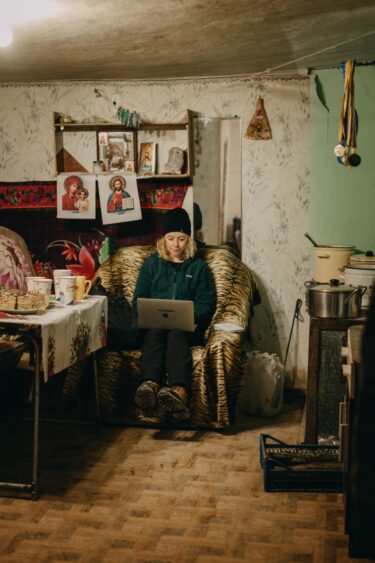
You spent Christmas and New Years in a dangerous foreign environment? What is that emotional landscape like?
In California, there were many years I spent Thanksgiving or Christmas in fire zones with people who had lost everything. So this wasn’t that strange for me. In weird way, it feels more odd if I’m with my family on the holidays because I’m so used to working.
For Christmas, I wanted to tell the story of soldiers on the frontlines who were trying to make Ukraine’s 12 traditional Christmas dishes. We drove out into the Donetsk region to a little house that was serving as a military command post. At the house, this soldier with a big frizzy beard was rushing around slicing potatoes and gutting fish. The house had no running water, and yet he was managing to put together this incredible feast. Getting to watch him work and waiting for the other soldiers to come in made me realize we’re all more similar than dissimilar. I thought this wasn’t too different from what my family was doing at the same time in Nebraska — making food and enjoying time together, even if our family unit was incomplete.
One my favorite parts was when the soldier started tucking coins into the potato dumplings. If you bite into a dumpling and hit a coin, it means you’ll have a year of luck and wealth. He insisted, “You have to eat one!!” When the dumplings were done, he gave us all a little dish. I was the first to bite into a coin and I thought, This is incredible! This is exactly the kind of thing that you hope for when you’re meeting new people and telling stories that really matter, and just getting to be part of it.
A moment from that story:
Hunched over a camping stove in the entryway, pots of water boiling, the only window turned liquid from steam. Slotting wood into traditional oven — the size of steamer trunk — to bake stuffed cabbage rolls, called holbutsi. Stmaping dumplings from homemade dough with a yellow coffee mug. He moved in short, quick movements — his beard frizzy and graying, his laughter quick to explode — as he darted between rooms, through a door propped open with an ironing board.
Myron, who is being identified only by his first name for security reasons, knew the soldiers in his battery were cold and discouraged. They rotated through the trenches, running artillery reconnaissance on Russian forces several kilometers away. Now, they are stationed in a village where blue tarps cover homes where the roofs have been blown off, and vehicle checkpoints are dotted with Christmas trees. It is a blip in a region bearing the scars of last year’s fighting — streets dark and emptied, sunflower fields seeded with mines — even after liberation from Russian occupation last year.
What precautions do you take to ensure your stories don’t endanger the people you’re writing about? It sounds like the military is cautious about disclosing certain facts to reporters. In one story, you note: “Ukraine does not publicly disclose its number of military casualties and has declined to specify how many marines were killed in the mission.” And how do you fact-check?
The local producers are from Ukraine and understand what’s at stake. I always have them back-read my stories when I’m done writing to make sure that I didn’t misunderstand the translation or include anything that would endanger someone’s life. David, the Ukraine editor, is also a wealth of knowledge and helps.
You have audio from the interviews, so you can fact-check against that. The local producer calls and double-checks things with the authorities — giving them a chance to respond — to ensure we have the correct information. You aren’t just doing it by yourself, which very weird for me because I’m used to doing all of the fact-checking and reporting on my own. It’s amazing to work in a team. There’s a lot of trust. I wish we could do this all the time!
What is your relationship like with the local producer?
It’s a total mind-meld. The main producer I worked with, Serhii Korolchuk, is so smart and intrepid, and his English is phenomenal. He was able to translate nuances. Working with him was so easy. It’s like a game of telephone. The person you’re interviewing is talking and you’re paying attention to their body language. I would find myself nodding my head or reacting just based on how they moved. Serhii would then translate what they said into English. I would ask another question and he would translate it back. It was intimate in a way that I didn’t expect. You’re so deep in this conversation that you almost forget there’s a language barrier.
I want to ask you about a scene from a particular story: “Russia unleashes missile barrages at Ukraine as holiday airstrikes persist.” There’s a scene right after a missile strike and you describe it in a way that makes me think you must had to have been there when the ground was still smoking:
One ambulance’s windshield splintered. In a nearby liquor store, bottles shimmied off their shelves and smashed to the floor. The smell of natural gas wafted through the air. Debris lofted into the park below, where benches had been knocked sideways. Nestled among the damage was a teddy bear.
These are such specific details that I figured this was an observed scene — not details you learned in an interview. Where were you when the missile hit? Were you in danger?
That was one of my last days in Ukraine, at the end of a few grueling days. We had news duty on New Year’s Eve and New Year’s Day. We basically just worked for 36 hours straight; my eyes were so red. On the morning of January 2, we were planning to celebrate by going out to breakfast as a team. Instead, we were rattled awake at 7:30 am by these huge missiles going off a few kilometers from our hotel.
We were raring to go, but our security guy said, “I’m going to take a shower.” He always tries to slow us down because a big issue with these strikes is that Russia will often “double-tap.” They’ll fire one missile and after it hits, they’ll wait for emergency personnel to arrive and then they’ll fire another missile. On this morning, that’s what happened. So his shower actually was probably a good thing, because we weren’t there when the second missile hit.
When we got there, the ambulances that had reported to the first strike had been shattered. And it was just mayhem. People walking around without shoes. People crying, dragging their dogs around. I remember so clearly seeing this mom and her little boy. He had blood just seeping out of the side of his head and got it all over his mom, all over her face.
I think people get really tired of hearing and reading about bad news. So whenever I am telling stories, I think about how to humanize my writing in a way that would make someone pay attention for just a sentence longer, a paragraph longer. I want to make them interrogate why they think what they think or make them feel something — to remember that this war still matters, even though it’s been going on for so long. Those are the things I’m always looking for when I’m on scene. I’m not only looking at the building that just got bombed but looking around it. What’s in the park? How are the local businesses reacting? How does it feel to be there in that moment? If I can make a reader feel something the way that I felt it, I consider that a success.
How did you approach the woman and her injured son?
I had watched them for a little while. When I felt like there was a break — she was standing outside of the ambulance while he was inside to get his wound dressed — I went up to her with the photographer, Wojciech Grzedzinski, who was helping me out with translating since my local producer had already departed. I asked her name and where she lived and if she could tell me what happened. I knew we would probably only get two or three minutes with her before they took the little boy to the hospital. But it was really all we needed to get those details about who this kid was and what their lives had looked like before this missile hit.
What was her response? How did she react to being interviewed in that moment?
She was really open to it. There’s this misconception that people who are going through the worst days of their lives don’t want to talk to journalists. But I’ve actually found the opposite to be true. There’s some comfort in your story being heard. Being seen. Being able to share your pain in a way that makes your experience feel like it means something. After the story ran, the mom emailed the photographer, who speaks Ukrainian. She basically said, We’re back home from the hospital. My son is okay.
I try to bring empathy and sensitivity to whatever story I’m working on. I want the people I’m talking with to know they’re respected and that their stories aren’t being taken from them — that the things they say matter and might help others understand what they’re going through. So that email was very affirming.
One of my favorite stories you’ve written is, “She’s sixteen. The war in Ukraine wrecked her city and her childhood.” You mentioned earlier that you knew you wanted to find a teenager whose life was interrupted by this war. How did you find Kate?
We were trying to find the right teenager in the right place. A kid who was on the front line somewhere, or whose life had been impacted by the war in a really intimate way. Our driver grew up in a city called Izyum, which had been under Russian occupation. His mom worked at a kindergarten with a teacher who had a teenage daughter. They’d lived in a bunker for several months. She had just turned 16, which I really liked, because 16 feels like such a poignant age.
From the story:
Kate was there as 80 percent of Izyum was razed, as more than 1,000 of her neighbors were killed. She was there when teh city — an important transporation hub in eastern Ukraine with a preinvasion population of about 45,000 — was liberated in September 2022.
Her classes are still online. Her friends are displaced. Her crush is in a different country. Her beloved woods contain mines and at least one mass grave. Still, she thought that 16 would be different — more freedom, more maturity. But her birthday came and went on Dec. 4, and now it is just more of the same.
“I thought, ‘Wow, cool. I will be so grown up,'” Kate said. “And I feel like a 10-year-old child.”
Nearly every day, she walks — remembered what her life was, escaping what it has become — until her legs ache and her mind goes blank.
The story about Kate notes “three days of interviews at her home.” Can you tell me what that three days looked like? I’ve been thinking about the progression of interviewing for narratives. In my process it starts quite broad, with open-ended questions, and gets narrower and more specific with each subsequent interview. When you’re writing a narrative, what does interviewing process look like for you?
You totally nailed it. I feel like the secret is starting broad, especially when you’re interviewing people who have gone through something that’s traumatic. You don’t want to just push them into the deep end before they trust you. I usually start just by asking whoever I’m interviewing to show me things — on their cell phone, in their environment. It’s a good way to make people feel less observed. It’s more participatory, instead of just, Here’s this journalist staring at me and barraging me with all these questions! Kate showed me her bedroom and I asked her about things I noticed. What’s this Christmas ornament? Did you make it? Where did it come from? This box under your bed — what’s in there? We went through the box, where she’d stored her birthday cards, and she played me a song on her guitar, then gave me a little tour of the rest of the apartment. Her mom was there, and we all talked and made sure everyone was comfortable.
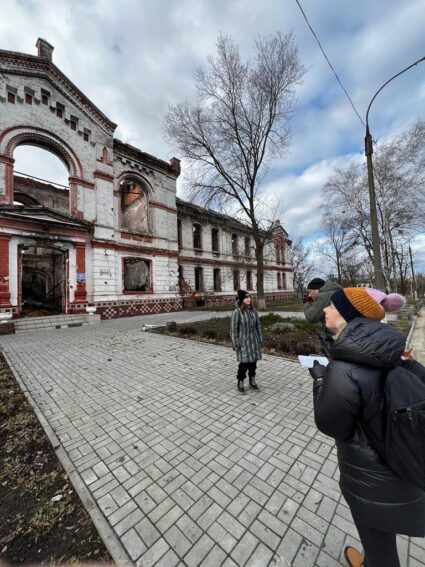
After that, we walked up the street to see her and her mom’s real apartment. They were staying with her grandparents for the winter because their apartment had suffered damage during a missile strike. It had no heat or running water and wasn’t habitable in the colder months. Kate showed me her childhood pictures and her art books. I feel like it’s easier for people to share their memories if you make it more open ended. Can you show me around? What do you think of when you look out the window? What are your favorite memories there? I let them take the lead. So that was the first day.
On the second day, we showed up to hang out with Kate. It was the photographer, the local producer and me. We wanted to shadow her through a typical day but she said, “All I really do these days is walk.” So we decided to walk with her. I remember thinking we’d walk for half an hour or so. Then we ended up walking — I kid you not — all day. We followed her around for miles as she walked her different routes. She would point things out. “Oh, that’s my school.” Or, “That’s where I used to go rollerblading.” Or “My parents met in that park.” She talked a lot about wanting to be alone. “Oh, I’ll come sit over here by the soccer fields, but if anyone else comes, I’ll move because I just want to be alone.”
The last day we just spent time with her at home. We ate breakfast with her and her grandmother. By the third day, I usually have a list of follow-up questions, including some of the harder questions. But I always want to make sure I have time to leave someone in a good place. You don’t want to ask them really hard questions, and then up and leave.
I’ve been thinking about the importance of the last interview. How do you prepare the person for the magnitude of the story that’s going to come out and the response they might get?
I try to address the magnitude on the front end of a story. I’ll tell them, I don’t want to be here unless you want me here. I know it might seem weird to have this strange person in your home with you all day. If you need a break, just let me know — I can go get a coffee and come back. If you want to look at my notebook, you’re welcome to look at my notebook. I want them to feel comfortable and like they’re part of the process, versus feeling like something is being taken from them.
Then on the last day or toward the end of a reporting trip, when I have a sense of the harder questions I need answers to, I’ll usually explain, I have some harder questions for you. And you don’t have to answer them if you don’t want to, and if you need a break, that’s okay. Then I ask the hard things: What was it like for you, having your stepdad get taken as a prisoner of war? What was it like living in the bunker? Do you feel like your childhood was sped up because of the war? You talk a lot about feeling like you’re still 14. Can you tell me about that?” I really want to get inside their head and understand how they think and feel.
I always end with future-focused questions. What gives you hope? What are you looking forward to? What plans do you have? Kate felt really loyal to her mom. She wanted to give back to her mom and talked a lot about wanting to get her mom a new car — her old one had been stolen by Russian soldiers — and take her to the Seychelles. So that felt like putting her back on solid ground, thinking about what was ahead of her versus what was behind her.
In writing about war, I imagine it’s not too hard to find a narrative lead with tension. There are probably scenes happening around you all the time. But how do choose an ending when you’re still living in the middle of the narrative arc?
With beginnings and endings, I tend to feel it when I’m in the moment. When I was talking to Kate on the last day, I asked what she was going to do with the rest of her day. She said, “I’m just going back to bed.” I thought, That’s it! That’s the end of the story! She’s a teenager. It may be late in the day, and she might be living in a war-zone, but like any other teenager, she’s going to go back to bed. I think beginnings and endings are about finding the universal in the specific. Those scenes that make you feel something. If I really feel something as I see it, I’ll put a star next to it in my notebook.
When you are immersed in details and individual lives, is it hard to zoom out and see the context of the bigger picture? How do you do that?
At the Post, we call it “the sweep.” We need that sweeping Washington Post sentence or two at the beginning of the story to explain why the story matters. In this story, it was something like, Kate’s lucky compared to some of her friends, but it’s still really hard for her to make sense of a war dragging into its third year. The sweep is specific to Kate, but it also gets at the broad idea of what’s happening to youth in this conflict zone and why it’s important to care about them. This is why you should pay attention to this 16-year-old.
How do you feel about nut grafs?
I like nut graphs that don’t seem like nut grafs. I don’t like it when nut grafs feel like a departure from the story — when you’re shoving them in there just to say that you have one. I think it better serves the story if you can make the nut graf feel part of the story. But you’re still telling readers why what they’re reading is important and how it pertains to the bigger topic of the war.
What was the hardest part for you about your time covering the war?
You really connect with the people that you’re writing about, and it can be really hard to see how painful their reality is. Sometimes I wish that there was more than I could do. I feel so privileged getting to walk into the story and do this work, but I also know that I get to leave at the end of the story — to go home to a place where I don’t have to worry about a missile blowing up my apartment building in the middle of the night or my brother getting conscripted into the army. Bearing witness to their reality is painful. You have to believe that the story will help, that it will serve them, that it will do something. Yet sometimes I wish there was more I could do.
* * *
Kim Cross is a freelance journalist and nonfiction author based in Boise, Idaho. Her new book, “In Light of All Darkness,” is about the FBI investigation of the 1993 Polly Klaas kidnapping.
